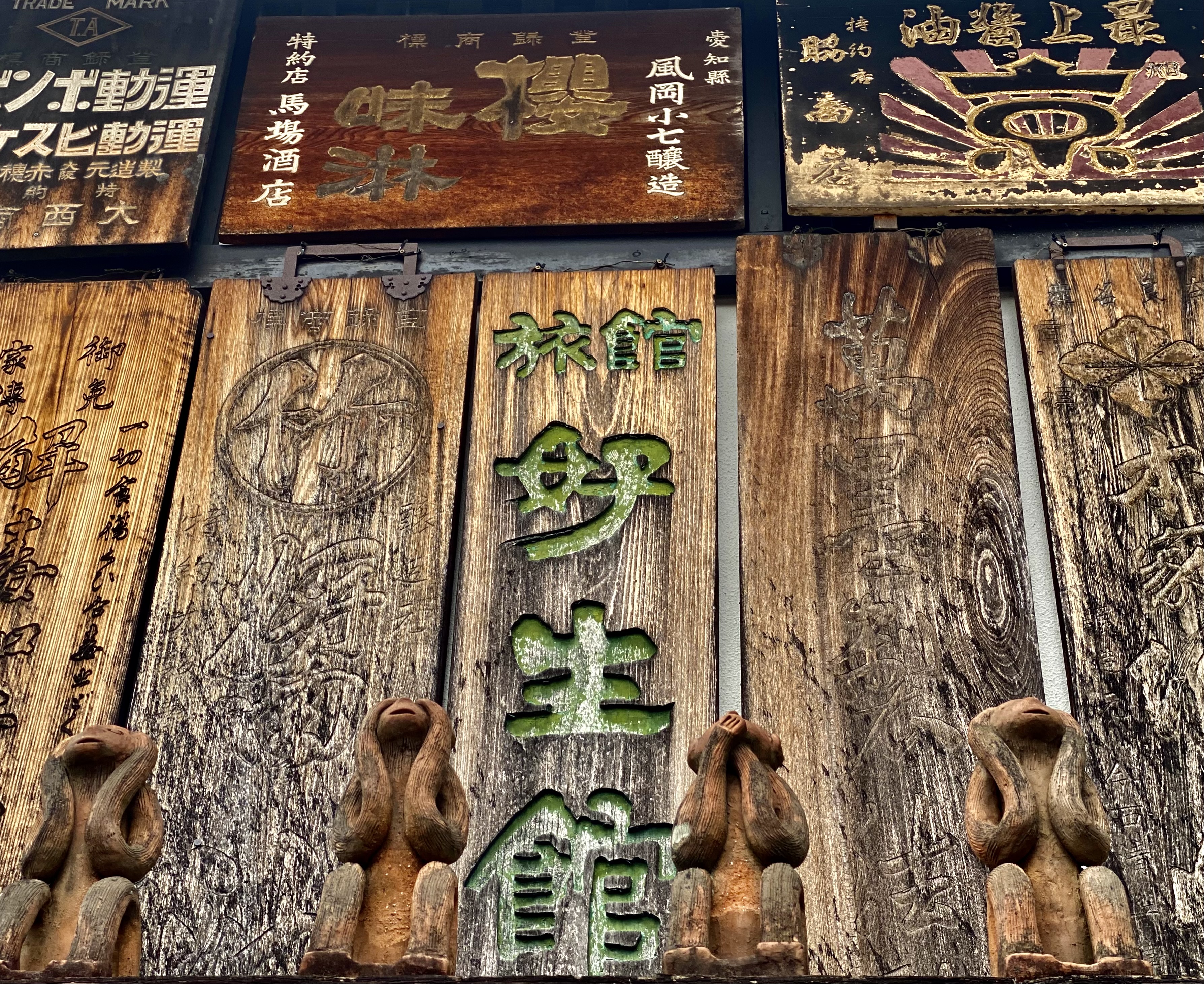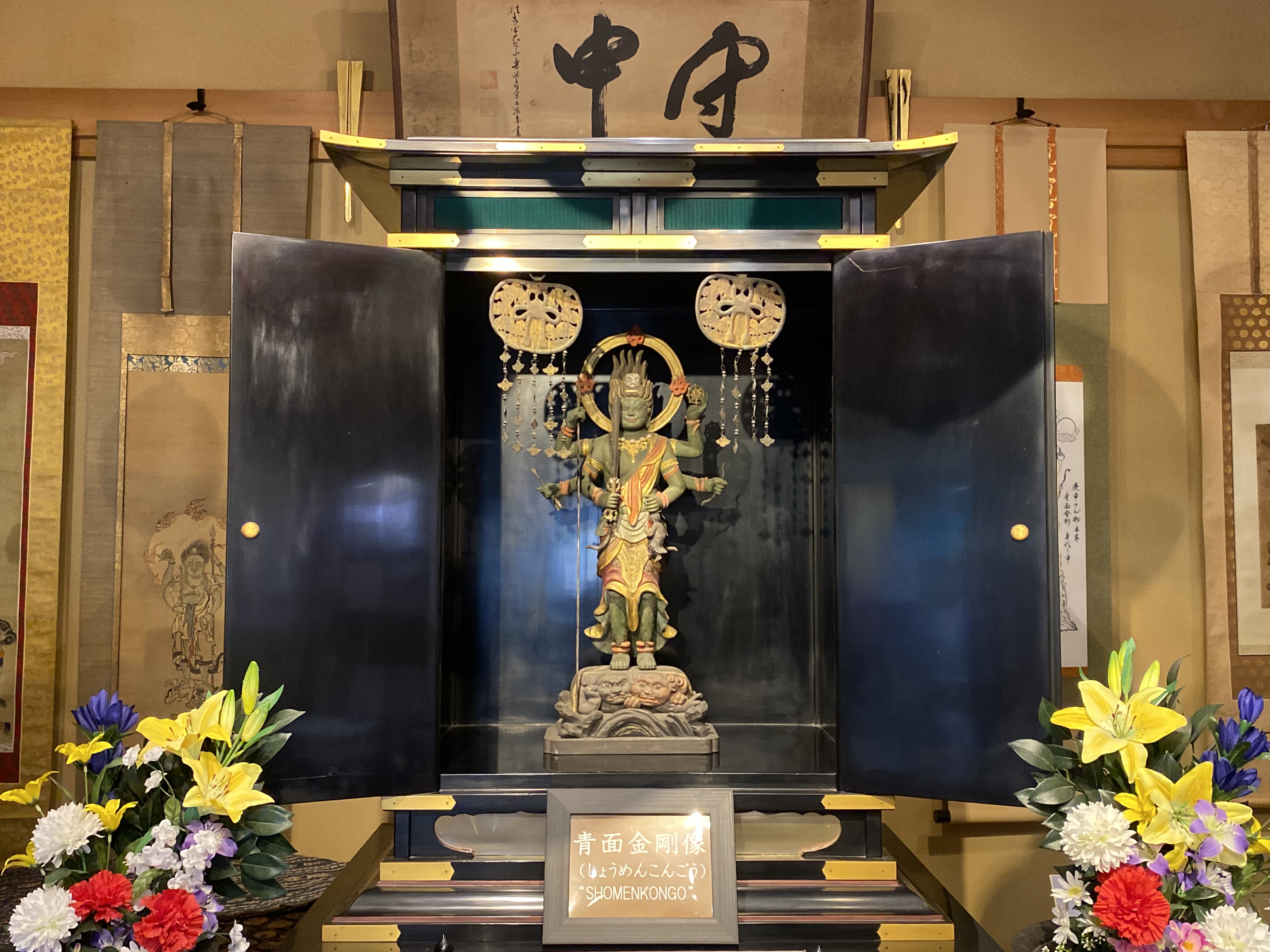Naramachi, Daoist Beliefs in Japan, and Three Wise Monkey Charms
2024/05/29
Throughout the Naramachi district of Nara City, a cluster of neighbourhoods to the south of Kohfukuji temple characterised by well-preserved machiya merchant houses from the Edo period (1603-1868) (like this one), are found strings of round red bundles, hanging from the buildings’ eaves or next to their entrances. They are found in such abundance that they almost stand as a symbol of Naramachi, and their meaning would probably be a surprise to most visitors to the area. The presence of Buddhism and Shinto in Nara is strong, but the set of beliefs behind these hanging bundles derive from Daoism. They arrived in Japan from China almost as early as Buddhism did, and developed from an aristocratic custom into one practiced by villagers and townspeople – that involved all-night parties and storytelling.
The Daoist belief that was adopted in Japan was of three worms (Ch. san-shih) that reside in different parts of the human body and exercise the functions of both recording one’s deeds and of inflicting illnesses that range from heart palpitations to a stuffy nose to melancholia and baldness. This was essentially an old belief system that accounted for disease and mental suffering by linking it to morality (and (seemingly) using concepts around parasites), since the worms were also invested with the capability of exiting the body and reporting the misdeeds of their host to the ruler of heaven – who in turn determined the lifespan of the person in question. Because the worms could leave the body only when the host slept, the only defense available to the latter against their internal attackers was to remain awake on the days designated for the reports. And so emerged all-night vigils called “Koshin-machi”. Eventually, in Japan, these became lively nights of entertainment during which the local community would gather to see the night through together.
The link with the red bundles is neither obvious nor easily explained, but some customary punning on the dual pronunciation of Japanese words has been suggested as a way to explain the connection. It is thought that the “shin” component of “Koshin” (a word that is simply the name for the days of the year when the dreaded reports take place), which is one pronunciation of the Chinese character for “monkey”, may have led to the association with the Three Wise Monkeys that famously “See No Evil, Hear no Evil, Speak no Evil”.

The “Three Wise Monkeys”, seeing, hearing, and speaking no evil on the roof of the Naramachi Shiryokan Museum
This is why, at the halls that are still found around Japan, and that are still quite numerous in Nara, one will often see representations of these Three Monkeys. But the association also extended into the Daoist ideas of the worms and of the heavenly judge (but possibly a narrative stretch): the hope was that the worms or the judge would likewise see, hear, and speak no evil.
The wordplay goes even further with the double meaning of the word “saru” (the other pronunciation of the character for “monkey”): it also means “to expel”. The little red bundles are monkeys, but they are also superstitiously deemed to absorb bad luck and illness from those who hang them on their houses. Thus, the decorations all over Naramachi are not just decorations but also lucky charms – representations of the belief in scapegoat logic. They are called Migawari-zaru, or “replacement body monkeys”. Such replacements are found in Shinto as well, where even today at some shrines there is a healing custom of using white paper cut into the form of a human body and marked by the petitioner on the places affected by their illness, and then set down a river. The current carries the displaced afflictions away from the living human body. One can also find certain Buddhist statues that are famed for absorbing the physical illnesses of the worshippers through the touch of the worshipper onto the corresponding part of the statue’s body. One of these, a well-worn wooden statue, is seated to the right of the entrance to Todaiji Temple, and another, a Kannon Bodhisattva, is at the Naramachi Shiryokan Museum. There, she is surrounded by numerous Migawari-zaru, perhaps multiplying her healing power. Japan has a very rich collection of other related exorcistic practices. The red monkeys often have wishes inscribed on their backs, which believers hope will be transmitted and fulfilled.
An interesting flipside to this set of beliefs that originally must have been fear-inducing is that, as time went on, the all-night vigils developed into parties that themselves developed game-playing and storytelling – including the telling of ghost stories as a way of keeping people awake, a genre that Japan for which is still famed today (and that feeds into its acclaimed horror film culture). It seems that one form of fear was replaced by another, but also that one form of religious culture developed into a secular one.
The Naramachi Shiryokan is an eclectic little private museum now run by the son of its founder based around this part of Naramachi’s history. It houses some valuable icons related to the unusual faith including hanging scrolls displaying the deities involved, and statues – it absorbed all kinds of other ideas. It also displays Edo-Taisho (1912-1926) period paraphernalia and offers Migawari-zaru for sale. The worship and the vigils have almost entirely disappeared from Japanese life and memory, as has knowledge of the Daoist ideas that once put fear into the hearts of believers – but its remnants exist in the form of the (quite literally charming) little red bundles adorning Naramachi.

Shomen Kongo, an esoteric deity absorbed into Koshin faith in Japan, on display at Naramachi Shiryokan Museum
Naramachi Shiryokan Museum – location here
14-3 Nishinoshinyacho, Nara, 630-8334
From Kintetsu Nara Station:
20 minutes on foot from the station.
Website (Japanese only)
Opening Hours: Exhibition area at front of museum, which displays items related to Koshin beliefs: 10-4 Daily- but visitors are advised to consult the calendar here for irregular closures marked on it.
Exhibition area at back of museum, which displays historical paraphernalia: 12-3pm Saturdays, Sundays, Holidays.
Admission free
![Private: [Day Trip] Private Full-Day Nara Tour from Osaka](https://nara-sightseeing.com/ns/wp-content/uploads/2020/02/naradeer.jpg)
Welcome to Nara, the birthplace of Japan! This is a one-day tour with a chartered car from Osaka to Nara. Head out from your hotel in Osaka with an English-speaking guide and take a car to Nara City. You will make your way around the main spots of Nara City,…
from124,000JPY

01
FIND YOUR FAVORITE
TRIP ON OUR WEBSITE.
SEND US AN INQUIRY.

02
PERSONALIZE THE TRIP
TO YOUR INTERESTS
WITH OUR CONSULTANT.

03
20% DEPOSIT TO CONFIRM.
BALANCE PRIOR TO ARRIVAL.
PAYMENT BY CC OR TT.

04
WE WILL
MEET YOU
AT THE AIRPORT.

05
DISCOVER THE
TREASURES!